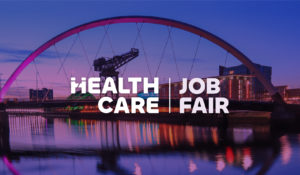The COVID-19 pandemic forced us to turn to technological solutions to ensure that society could continue ticking over even as most of us were relegated to our own homes. Classrooms, office spaces, college tutorials and hangouts with friends migrated to the digital sphere as we tried to maintain our critical connections and stay one step ahead of our loneliness over the very worst of our pandemic-enforced isolation.
Job fairs, too, transplanted to the digital arena. With stringent social distancing measures and caps on congregations in place, job fairs shifted to a virtual interface, with recruiters and candidates flocking to platforms such as Zoom. Virtual job fairs allowed candidates and employers to continue to connect during the pandemic. As COVID has retreated, virtual job fairs have found their staying power, with a number of traditional job fairs having made the switch to virtual environments entirely even as society has opened back up.
But are virtual job fairs right for the healthcare sector? What are the pitfalls, and what are the arguments for healthcare employers returning to in-person job fairs in the post-COVID recruitment landscape?
Because We Haven’t Just Tried Them – We Pioneered Them!
As it happens, we were the firm who broke ground on the concept of virtual job fairs in the UK and Ireland, back in 2010 – albeit, under the banner of WorkingAbroad, before we operated under the HealthSectorTalent® brand. Our experiences bringing virtual job fairs to an at that time untapped market for online talent acquisition demonstrated enough shortcomings that we were convinced to eschew the medium altogether.
Chief among these pitfalls was what we termed the Feast or Famine phenomenon. Employers experienced either no candidates logging on on the day, or too many for them to possibly engage with through digital means. This can be extremely frustrating when employers are conscious of the ticker showing a wealth of candidates in the virtual job fair’s lobby, but are stuck engaging one-on-one with a single candidate at a time. In a real world scenario, employers manning a stand have the ability to physically corral groups and host conversations with multiple candidates at once, or signal to candidates still waiting for a chat that they’ll be with them shortly. Other times, candidates failed to show up at virtual job fairs at all, leaving fully-manned hiring teams sitting twiddling their thumbs in an empty chatroom. The massive and unpredictable variance in candidate numbers made virtual job fairs an uncertain time investment at best. Worse, on the occasions where candidates did turn out in droves, the one-to-one nature of virtual job fairs meant employers didn’t have the same capacity to take advantage of that volume that they would have had in a physical environment.
Virtual Job Fairs Lack the Personal Touch
All this goes to show how the personal connection is the single greatest selling point of an in-person job fair. Free from the rigid, often one-sided structure of job applications and interviews, jobseekers at a job fair have the breathing room to be themselves and allow employers to get to know them on a much more personal level. A more relaxed environment lends itself to the kind of exploratory chatter that can unearth information that may not emerge in the staid confines of a job interview or online job description, for jobseeker and employer alike.
This means a more honest appraisal of the jobseekers your hiring team is engaging with, and a chance for those jobseekers to feel out your organisation and figure out if the role is the right fit for them. Healthcare relies perhaps more than any other sector on interpersonal interaction and personable staff. Being able to chat directly with your prospective hires in a relaxed setting gives you the opportunity to get to know them as more than a CV and set of qualifications, and gives you the space to judge whether their personality and character mesh with the values of your organisation.
Of course, when a job fair moves online, this invaluable component gets lost in translation. Time-gated interactions leave candidates and employers pressed to hit the key notes of their respective pitches and move on to the next offering. The impersonal digital format takes away much of the spontaneity and humanity of a traditional job fair, with its natural ice-breakers, free-flowing conversations and goody bag takeaways that open up dialogue and create lasting impressions that help clinch discussions. The virtual setting boils the job fair format down to a sort of interview speed-dating, with a succession of digital interviews in rapid succession that provide neither the incisive depth of a job interview nor the wide-ranging scale and flexibility of an in-person job fair.
Less Tech-Savvy Candidates May Not Feel Comfortable
While it’s true that computer literacy is dramatically improving with every passing year, healthcare workers tend to skew older and may not be as comfortable with new digital technologies as younger generations. The average age of nurses in the United States is 44; for doctors, it’s even older, at 53. Moving your healthcare job fair recruitment efforts online runs the risk of alienating a significant percentage of your potential audience before you can even get them through the digital gates.
Of course, an even bigger concern than tech literacy among your candidates is simply the potential for tech errors. Spotty internet connections can leave either a candidate or a host unable to log into the call, while freezes and glitches during a conversation can lead to miscommunications and misunderstandings. This, likewise, may deny your organisation a significant swathe of potential healthcare recruits, as an increasing proportion of health workers, notably nurses, are sourced overseas. If candidates don’t have access to the premium internet speeds required to access an hours-long virtual video call, they may shun such an event entirely.
This may not be a problem with some virtual job fairs specifically targeting recent college graduates in a specific region, or catering to specific skillsets for a domestic market, but it’s a major hindrance in healthcare, which by necessity draws recruits from across backgrounds and geographic regions. Erecting arbitrary technological barriers to even get face time with your organisation puts you at a disadvantage in the fierce competition for recruits amidst ramping healthcare shortages all over the world and across all sectors.
Pay-to-Play Leaves Smaller Recruitment Budgets in The Cold
One standout advantage of in-person healthcare job fairs is that they provide an even playing field in the aforementioned contest for sourcing desperately needed healthcare expertise. From individual NHS Trusts to private hospitals, any healthcare organisation can come to a job fair and pitch themselves to the same pool of talented professionals. Buying space at a job fair means buying into an unadulterated pool of professionally assessed healthcare talent with equal claim on anyone as a potential hire. This allows you not only to recruit for your immediate organisational needs but to build a talent pool in reserve for future hiring campaigns.
Virtual job fairs have a propensity to undercut this critical benefit by offering slots in their line-ups in a “pay-to-play” scheme, where recruiters can pay extra to be shunted up the priority order to take first pick of the candidates on offer. This prioritises larger recruitment budgets and means that those organisations that filter down to the back of the queue are left with comparatively slim pickings, with the best talent already being snapped up by those at the front. This can skew the experience against organisations who can’t shell out lavishly on recruitment budgets, and undermine the purpose of attending a job fair in the first place.
Healthcare Recruiting Requires Scale a Virtual Job Fair Can’t Provide
The entire healthcare sector is facing absolutely critical staff shortages – most notably of nurses and midwives. With healthcare systems everywhere straining under the stress of understaffing and increasing caseloads, organisations have an imperative to source high-quality candidates in batches that most recruitment strategies are proving too inefficient to fulfil. This is where the sheer scale of a physical job fair can be of immense service in meeting the exacting demands of healthcare organisations’ hiring teams. It is also indicative of why a virtual job fair, for many of the reasons outlined in detail above, may prove insufficient to meet an organisation’s needs.
Where a virtual job fair might net a couple hundred candidates (those that are not already filtered out by aforementioned technological barriers), of those, any job fair operating a pay-to-play scheme for exhibitors will further winnow down that pool before every exhibitor has had a chance to open discussions with everyone available to them. Physical spaces by contrast can offer rolling foot traffic of upwards of a thousand people over the course of a day, all within reach of employers and all equally accessible for conversation. Where virtual job fairs may provide targeted recruitment opportunities for specialisations, a physical event can offer the traffic required to match the scale required to meet the challenges of the current healthcare landscape.
Don’t miss out on your opportunity to connect with motivated candidates, showcase your company, and strengthen your position in the job market. Visit the exhibitors’ page for the Healthcare Job Fair, or our partner events; the Nursing Jobs Fair or the Doctor’s Job Fair today.



 Previous Post
Previous Post 





